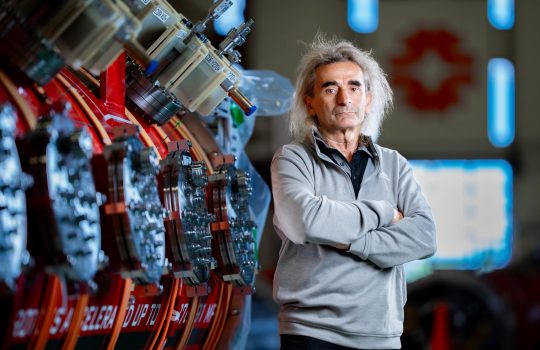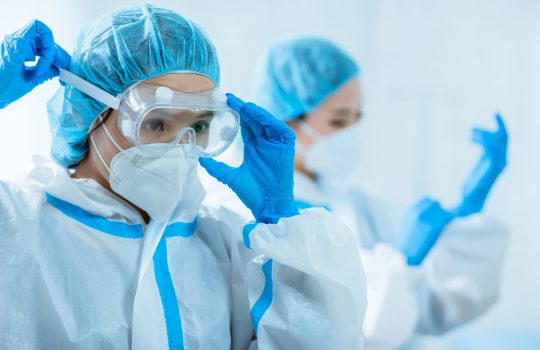Batavia, Ill.June 1 — The world’s newest particle accelerator officially began its life at the high-energy frontier today with the dedication of the Main Injector accelerator at the Department of Energy’s Fermi National Accelerator Laboratory.
Secretary of Energy Bill Richardson, Speaker of the U.S. House of Representatives Dennis Hastert and Governor George Ryan joined Fermilab staff and visiting scientists in celebrating the on-time, under-budget completion of the seven-year, $260 million project. “The dedication of the world’s newest particle accelerator is a landmark event,” said Secretary Richardson. “Completion of the Main Injector dramatically improves Fermilab’s capability to explore the fundamental properties of matter and demonstrates the Department of Energy’s commitment to keeping the United States at the forefront of high energy physics.” “Together with the recent completion of the B-Factory at Stanford, the successful completion of the $260 million Main Injector project proves that DOE can and does build large scientific projects on time and on budget. The research program at Fermilab, like our other fundamental research laboratories, brings together scientists from over 40 countries and provides an excellent example of the importance of international scientific collaboration.”
The new Main Injector is one of five increasingly powerful accelerators making up the Fermilab complex. Fermilab’s Tevatron, the world’s most powerful particle accelerator, creates high- energy particle collisions that allow particle physicists to explore the structure of matter at the very smallest scale. By increasing ten-fold the number of particle collisions at the Tevatron, the new Main Injector will multiply the opportunities for discovery for the hundreds of scientists from nearly every state and 45 countries who carry out particle physics research at Fermilab. “Having worked for years to make this project a reality, I congratulate Fermilab on its success in completing the Main Injector accelerator and providing the scientific community with such a a valuable resource for research and experimentation,” said Speaker Hastert. “Federal and state officials joined with physicists and engineers to create a powerful partnership that delivered this project to specifications and set an example to everyone in government by finishing the work on time and under budget.”
“It has taken seven years to reach this dedication day — a long time,” said Fermilab Director John Peoples, whose 10-year administration has spanned the entire project. “But what made the difference was the people who worked to get the Main Injector built — the public officials, physicists and engineers, designers, technicians, contractors, procurement experts, construction workers and safety experts whose vision, energy and hard work brought the Main Injector from a sketch on a drawing board to a living particle accelerator.”
Housed in a tunnel 30 feet below ground, the Main Injector is about two miles in circumference. Particles will travel around the Main Injector at nearly the speed of light, circling the two-mile ring nearly 100,000 times per second. The particles are then injected into the four-mile Tevatron accelerator where billions of particle collisions occur.
A $2.2 million challenge grant from the State of Illinois in 1991 gave Fermilab enough funding to take the first steps towards building the new Main Injector: carrying out environmental and design studies. Federal funding for the project was approved in October 1991, and construction got underway in 1993, after extensive R&D. The Department of Energy provides more than 90 percent of the federal support for research in high-energy physics in the United States.
Steve Holmes, who has managed the Main Injector project from its inception, noted the many obstacles the partners worked to overcome. “Over the years, the team working on the accelerator has experienced literally thousands of small victories and some not-so-small setbacks. We faced all the curveballs that fortune could throw us. Fortunately, we also smacked a few over the fence.”
In fact, the Main Injector team worked together so well that a new storage ring, the Antiproton Recycler, was added to the accelerator complex without increasing the total project budget or delaying its scheduled completion. The Recycler, which shares the new two-mile circular tunnel with the Main Injector, is the only accelerator of its kind in the world, using permanent magnet technology to retrieve, store and literally recycle antiprotons that previously would have been discarded. The Recycler saves costs and energy while adding to the efficiency and effectiveness of Fermilab’s collider experiments at the Tevatron.
The Main Injector enhances the opportunities for scientific discovery at the frontier of high energy physics, with the Tevatron still the world’s highest-energy particle accelerator. More collisions at the Tevatron mean more opportunities to discover new particles and new physics beyond the Standard Model, the current theory of the fundamental structure of matter. Scientists’ hopes are high for discoveries as significant as the detection of the top quark, first observed at the Fermilab in 1995.
We’ve taken a facility that already existed, and without spending billions of dollars remade it into a much more powerful physics facility,” said Fermilab theoretical physicist Joe Lykken. “We are looking ahead to a golden age of particle physics at Fermilab.
Fermilab is a Department of Energy National Laboratory dedicated to frontier research in the field of particle physics. More than 90 percent of the funding for federally sponsored research in particle physics is provided by DOE. Fermilab is operated by Universities Research Association, Inc. under contract with DOE.
For more information, call Fermilab’s Public Affairs Office at (630) 840-3351.



